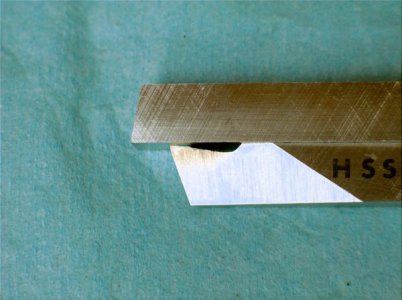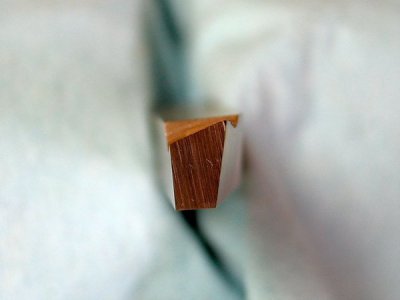- Joined
- Dec 20, 2012
- Messages
- 9,422
I have a question about back rake angle, what is a back rake angle?
why it 's not needed with a QCTP?
if it is not often ground in a turning tool then why do we even mention it?
... nowadays most people who grind their HSS cutting tools for turning and facing,do not incorporate a back rake angle in their cut but it's always mentioned .
Ken, I'll try to explain back rake but you must keep in mind that while it is, in fact, an angle on a turning tool it is one of two angles that determine a plane. This plane is actually a combination of the side rake and back rake angles and together they form the top horizontal surface of a turning tool. This plane can be angled in a positive, negative or zero direction, depending on how these two rake angles are ground. Here you can see the back rake angle from the side; it is that angle under the bit sitting on top of the ground tool:

Note that it slopes from the tip of the tool so that the back of the angle is lower than the tip; this is called positive back rake. Keep in mind that the entire top horizontal surface (the top plane) of the tool is also sloping back in a positive direction. Side rake is the other component of this top plane and it is sloping away from the tip as well so it is also positive.

So, as you can see, the top surface or plane of the tool is actually a flat plane, the angle of which is determined by the side and back rake angles.
Both rake angles can be positive, negative or zero. Just look at the tool from the tip. If the angles slopes away from the tip then the rake is positive. If it slopes toward the tip then its negative. If there is no slope to either rake angle then it is a zero-rake tool and is simply flat on top.
I know your question pertains to back rake but no tool angle works in isolation and the rake angles are no exception. The rake angles are the most important angles on a turning tool because they have a tremendous impact on cutting forces and cutting temperatures. In fact, they are the key set of angles that change when a tool is ground for different materials. If you look at a turning tool angle table, you will see that the relief angles change a little for each material class but the rake angles are the main variables that allow the tool to work with different materials. As the tool cuts, it separates the chip along a plane called a shear plane and each material we turn has an optimal shear plane angle that clears the chip from the cut. This is why the rake angles change for each material. I will stop with the shear plane garbage now but just know that back rake shortens the shear plane and thereby reduces cutting forces significantly. You can grind a tool without back rake but your tool will cut with higher cutting forces than it should/could.
So, what does back rake actually do (aside from its impact on the chip)? Basically, it alters the direction and speed of chip flow and also determines where the cutting forces are directed.
- Chip flow is largely determined by side rake. In general, cutting forces will run perpendicular to the side cutting edge. When you add in back rake, it changes the direction of the chip flow and the more back rake you have, the faster the chips exit the cut and this reduces cutting temperatures.
- If your tool has no back rake, all the cutting forces are focused on the side cutting edge. If you add back rake, you shift the cutting forces toward the tip of the tool and the more back rake you have, the more tip-ward the shift will be. This is why finishing tools, which cut with the nose radius, generally have larger back rake angles. On the other hand, roughing tools that cut mainly with the side cutting edge will have lower degrees of back rake. Facing tools cut mainly with the side cutting edge but up near the tip so these tools generally have more back rake than roughing tools but less than finishing tools. If you wish to see a video of how back rake shifts cutting forces, look up a video on tangential tools.
Tangential tools have what amounts to significant back rake and as it cuts you will see the chip curling off the very tip of the tool. As the depth of cut increases you can see that it peels off a chip at the very tip.
Between the two rake angles, side rake is more important than back rake. Side rake greatly impacts on cutting forces because increases in side rake narrow the included angle at the cutting edge, thereby allowing for better penetration into the material. Back rake adds to this effect by narrowing the included angle at the end cutting edge and this also improves penetration (on top of the other things back rake does).
There are as many ways to grind a tool as there are tool grinders. Some of us think back rake is not important; some, like me, think it is very important and I use it to help me make the tool do what I want it to do. Other than my threading tools and brass tools, all my turning tools have side and back rake angles ground into them and I tailor the amounts of each rake angle to suit the material I'm working with. Its okay not to grind back rake into your tool but it will cut better for you if you do.
Hope this helps, Ken.
